Korean Cha-Ru (Tonfa)
by
Grand Master James S. Benko
Historical Background
Cha-Ru in Korean (tonfa in Japanese) means “handle” It was believed to be used as part of millstones.
The projecting knob was inserted into a hole in the mill’s upper stone, and the longer shaft was used as a handle to rotate it against the lower stone for grinding grain and rice.
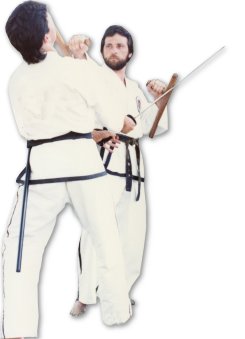 It is difficult to know for sure where the tonfa originated, and it has many stories about its origins. Many cultures have claimed it originated in their country, and many of the claims are from around the same era, making it unclear as to which culture as a legitimate claim.
It is difficult to know for sure where the tonfa originated, and it has many stories about its origins. Many cultures have claimed it originated in their country, and many of the claims are from around the same era, making it unclear as to which culture as a legitimate claim.
The one claim that has the most evidence is that this is a martial arts weapon used by the inhabitants of Okinawa. While it seems to be prevalent in the Okinawan martial arts, historians have traced its origins it China, Indonesia or Southeast Asia. Many martial arts were brought to Okinawa from China including weapon arts. This most assuredly included the cha-ru or weapons similar to it. The cha-ru may also be found in Thailand, Malaysia, Vietnam, and Cambodia.
The Okinawan version of the cha-ru was a traditional weapon was taken back to Japan by the Japanese martial artists as were several of the Okinawan empty hand martial arts styles. After the Japanese invaded and subjugated the people of Okinawa, and then re-named it “tonfa”. The cha-ru has since been integrated in several Japanese martial arts.
The Kingdom of the Ryukyu Islands and their governments were eventually taken over by the central Japanese authorities in 1879 forcing the Okinawans to speak only Japanese, follow Japanese customs and traditions. Only the Japanese language was to be taught in schools. It was the same tyrannical domination which had been forced upon the people of Korea since 1910, until Korea regained its independence after the defeat of the Japanese in 1945.
The Baekje Kingdom of ancient Korea was primarily the agricultural heart of Korea. Its lush plains, warmer climate and rich soil made the region a farmer’s paradise. It was generally this area from which the Korean cha-ru (handle) emerged due to the abundance of farms which proliferated this section of the country.
Strikes and Blocks
Strikes and blocks using the cha-ru are similar to martial arts movements. Blocks with the shaft of the cha-ru are similar to those performed with a forearm block. In fact, the forearm usually rest against the shaft of the cha-ru to give added support to the block. The huke yo pal moke makee (rising outer forearm block), or almost any other type of forearm block, are executed the same with or without the cha-ru, with one exception, the cha-ru practitioner holds on to the grip of the cha-ru for added power.
The punches common to the martial arts are also used with the cha-ru. A chirigee (punch) can be executed with the cha-ru by striking with the head portion of the cha-ru. A pon tay sudo ter ri kee (reverse knife-hand strike) is performed by striking with the grip head portion of the cha-ru.
The base section of the cha-ru may be used to generate backward elbow strikes to an opponent. The swinging action of the cha-ru can be compared to the kicks of a martial artist. Downward kicks, turning kicks, reverse and spinning kicks, can all be simulated by the flipping and spinning motions of the cha-ru.
Trapping Techniques
Traps and disarms are also part of the cha-ru’s arsenal for defense. Both the grips and shafts of the cha-ru may be used for trapping the opponent’s arms and restraining an opponent and/or his weapon.
X-blocks can prove quite effective in trapping a weapon or the arm holding a weapon. Once the X-block is applied, the arm and/or weapon can be re-directed creating an opening for a quick counter-attack. The X-block is formed by crossing both of the cha-ru's shafts, thus pinning the attacking arm or weapon between them.
Holding the shaft of the cha-ru, you can hook the grip around the opponent's neck, thus trapping him and cutting off his air. The wrists and arms of the opponent may be trapped by crossing the shaft of the cha-ru over them, then by applying pressure, inducing pain.
The hooking of the cha-ru around the opponent's next, either from the front or back, may be used to pull him to the ground or execute a thowing technique. Once on the ground a follow up strike or
joint-locking technique may be applied. The cha-ru may also be used to pin the opponent's arm behind his back to better control and/or disable him.
Disarms
Disarms are also part of the repertoire of the cha-ru’s multitude of combinations. The cha-ru may be used to strike the hand or arm of the person holding a weapon thus effectively disarming him. By using traps and then dislodging a weapon held by an opponent, the cha-ru can be useful in these types of disarms.
One of the primary rules self-defense is to "control the opponent's weapon". Disarm techniques are essential for controlling the opponent's weapon. A disarm will help ensure you will have a much
better chance of defeating your aggressor.
Multiple Range Capabilities
A distinct advantage of blocking or striking with the cha-ru is that of being able to extend its range beyond the length of the arm. By swinging the cha-ru in a circular manner while holding on to the grip, the shaft of the cha-ru provides added length thus making it easier to strike or block an opponent from a distance. This “added length” also helps enable the practitioner to keep opponents at a distance.
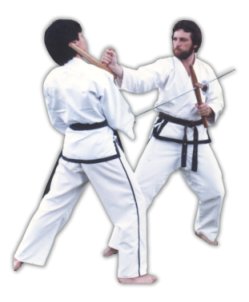 The range of the cha-ru may be varied. Holding it close against your forearm permits defenses and counter-movements at close range. When swinging the cha-ru while holding onto the grip, the user is able to defend and attack at both medium and long ranges. This ability to rapidly alter the ranges of attacks and defenses makes the cha-ru a versatile and extremely useful weapon for self-defense.
The range of the cha-ru may be varied. Holding it close against your forearm permits defenses and counter-movements at close range. When swinging the cha-ru while holding onto the grip, the user is able to defend and attack at both medium and long ranges. This ability to rapidly alter the ranges of attacks and defenses makes the cha-ru a versatile and extremely useful weapon for self-defense.
Though the head of the cha-ru is used for punching at close range or applying pressure to vital nerve related targets, by pointing the base toward the opponent as you grasp the grip of the cha-ru, and punching with it, the punch now becomes long range. This ability to rapidly very the range of punches, strikes and blocks can be very useful in any confrontation.
Variable Height Possibilities
One of the most useful methodologies for defending with the cha-ru is its ability to block, strike and counterattack with speed and accuracy at varied heights.
A rising block to defend against a downward attack can be simultaneously executed with low-section strike to the opponent’s knee. Blocking an opponent’s kick to the groin area can quickly be followed up with a high-section swinging strike to his head and a mid-section punch with the head of the cha-ru.
By dropping down onto one knee, a flurry of rapid cha-ru blocks and strikes can catch an opponent totally off guard. On the other hand, as an opponent executes a strike toward your knee, the cha-ru practitioner can either swing the cha-ru downward to block the attack, or jump into the air moving backwards while at the same time extending the cha-ru and striking the opponent in the head or other vital target.
Using combinations of ducking, bobbing, weaving, jumping, side-stepping, and kneeling maneuvers, the cha-ru practitioner can release a barrage of techniques to confuse and overpower even the most experienced opponent. Staying in one position does not fit the techniques of the cha-ru. The defender is constantly moving in order to make it harder for the opponent to strike or entrap him. Swinging a the cha-ru in a pattern, such as a figure eight, the cha-ru practitioner forces his antagonist to be on constant guard, not knowing if any one of the swinging cha-ru will strike him at any movement.
Weapon of Last Resort
 Though many martial artist see the cha-ru as a weapon used for self-defense. It must certainly have been a weapon used only as a last resort. A farmer, if threatened, could most assuredly choose a much more practical tool to be used for self-defense than the cha-ru. This is not to say that the cha-ru would not be an effective defensive weapon should the need arise.
Though many martial artist see the cha-ru as a weapon used for self-defense. It must certainly have been a weapon used only as a last resort. A farmer, if threatened, could most assuredly choose a much more practical tool to be used for self-defense than the cha-ru. This is not to say that the cha-ru would not be an effective defensive weapon should the need arise.
A scythe, used to cut crops or heavy vegetation would be a much more logical choice. A sickle (nat in Korean), used to cut rice or foliage, could have been found on most any farm and it too could help the defender in a self-defense situation. A pitchfork is yet another farm implement which could double as a defensive weapon which most farmers would have readily had available to them.
It seems highly unlikely that if any of these other tools were available, that a person would not choose the cha-ru over one of them. Both the pitchfork and scythe can more easily keep and opponent at a distance during a confrontation. These tools are much more ominmous looking to a potential attacker than the cha-ru. However, amny martial artist continue to use the cha-ru as a traditional martial arts weapon.
.
The cha-ru is one of the primary traditional weapons used in Korean martial art of Han Kuk Mu Ki Do™. It is the weapon which is used for advancement from 1st degree black belt to 2nd degree black belt in Han Kuk Mu Ki Do™.
Techniques are demonstrated by Grand Master Benko, with Master Nelson Curell.
|
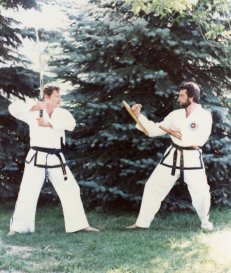
1
Opponent in an on-guard position with a sword. You take up a defensive stance using twin cha-ru.
|
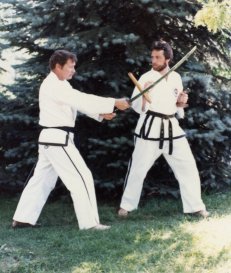
2
Opponent cuts downward as you deflect the sword with the cha-ru while stepping to the side.
|
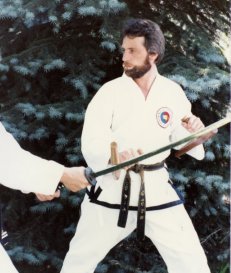
3
Close view of photo "2" showing the position of the cha-ru causing the deflection.
|
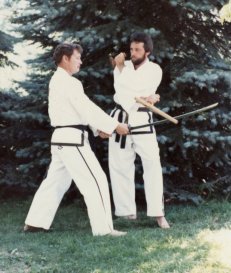
4
Bring your left foot to your right foot as you fold your arms and prepare your counter-strike.
|
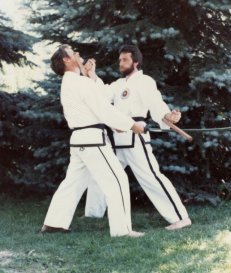
5
Step forward with your right foot, striking him with the right cha-ru. Left cha-ru pins the sword.
|

6
Pin the sword by striking it with the right cha-ru as you strike him in the head with the left cha-ru.
|
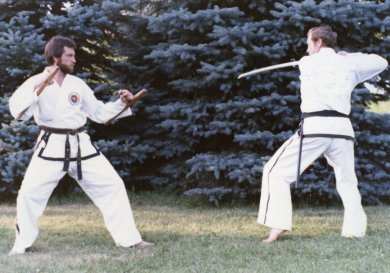
1
You assume an on-guard position using twin cha-ru. The aggressor is in an attack stance as he prepares to execute a sword thrust.
|

Anatomy of the Korean Cha-Ru.
Use this chart to refer to the names of the different parts of the cha-ru in this article.
|
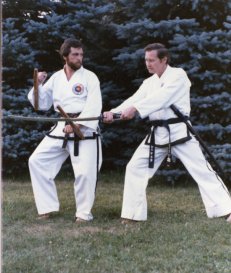
2
He thrust to the mid-section. You turn to your right re-directing the sword using the left cha-ru.
|
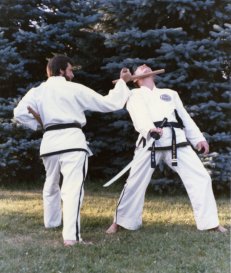
3
Turn quickly to your left as you strike the opponent in the jaw with the right cha-ru.
|
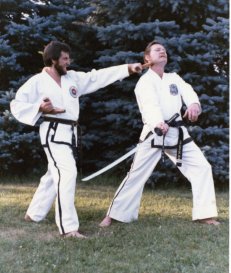
4
Shift sharply to your right as you punch the opponent in the head with left cha-ru.
|
Copyright © 1998-
James S. Benko and ITA Institute.
All rights reserved.
Top of Page
If you would like to learn more, you may wish to order the following DVD videos:
"Korean Cha-Ru (Tonfa): Volume 1"
"Korean Cha-Ru (Tonfa): Volume 2"
"Korean Cha-Ru Hyungs (Patterns)"
|